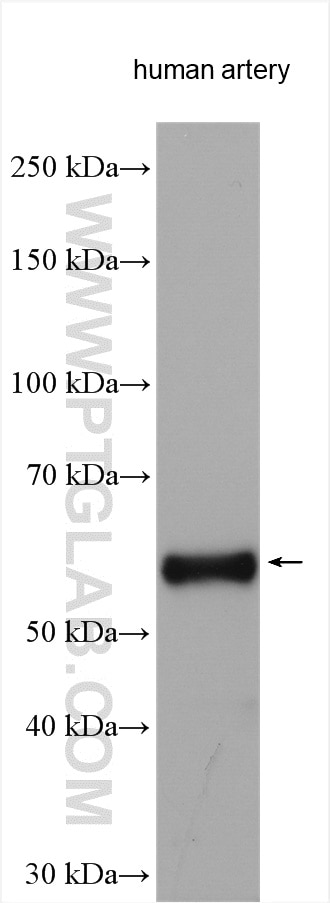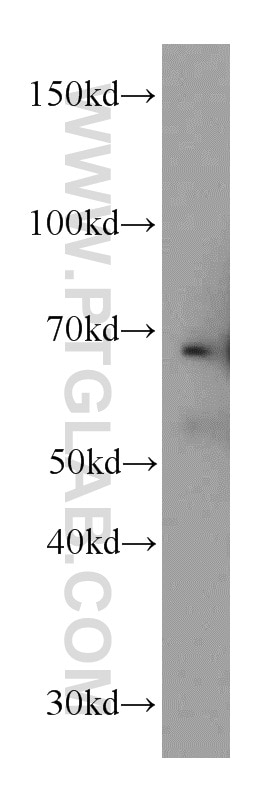Anticorps Polyclonal de lapin anti-Elastin
Elastin Polyclonal Antibody for WB, IP, IHC, ELISA
Hôte / Isotype
Lapin / IgG
Réactivité testée
Humain
Applications
WB, IP, IF, IHC, ELISA
Conjugaison
Non conjugué
N° de cat : 15257-1-AP
Synonymes
Galerie de données de validation
Applications testées
| Résultats positifs en WB | tissu artériel humain |
| Résultats positifs en IP | tissu placentaire humain, |
| Résultats positifs en IHC | tissu pulmonaire humain, tissu de cancer de la peau humain il est suggéré de démasquer l'antigène avec un tampon de TE buffer pH 9.0; (*) À défaut, 'le démasquage de l'antigène peut être 'effectué avec un tampon citrate pH 6,0. |
Dilution recommandée
| Application | Dilution |
|---|---|
| Western Blot (WB) | WB : 1:1000-1:5000 |
| Immunoprécipitation (IP) | IP : 0.5-4.0 ug for 1.0-3.0 mg of total protein lysate |
| Immunohistochimie (IHC) | IHC : 1:500-1:2000 |
| It is recommended that this reagent should be titrated in each testing system to obtain optimal results. | |
| Sample-dependent, check data in validation data gallery | |
Applications publiées
| WB | See 13 publications below |
| IHC | See 2 publications below |
| IF | See 2 publications below |
Informations sur le produit
15257-1-AP cible Elastin dans les applications de WB, IP, IF, IHC, ELISA et montre une réactivité avec des échantillons Humain
| Réactivité | Humain |
| Réactivité citée | Humain |
| Hôte / Isotype | Lapin / IgG |
| Clonalité | Polyclonal |
| Type | Anticorps |
| Immunogène | Elastin Protéine recombinante Ag7179 |
| Nom complet | elastin |
| Masse moléculaire calculée | 68 kDa |
| Poids moléculaire observé | 60-70 kDa |
| Numéro d’acquisition GenBank | BC065566 |
| Symbole du gène | Elastin |
| Identification du gène (NCBI) | 2006 |
| Conjugaison | Non conjugué |
| Forme | Liquide |
| Méthode de purification | Purification par affinité contre l'antigène |
| Tampon de stockage | PBS avec azoture de sodium à 0,02 % et glycérol à 50 % pH 7,3 |
| Conditions de stockage | Stocker à -20°C. Stable pendant un an après l'expédition. L'aliquotage n'est pas nécessaire pour le stockage à -20oC Les 20ul contiennent 0,1% de BSA. |
Informations générales
Elastic fibers are an abundant and integral part of many extracellular matrices, in which they provide the elastic properties to tissues such as arterial, lung, and skin. Elastic fibers are consisting of an elastin core surrounded by a mantle of fibrillin-rich microfibrils (PMID: 12082143). Elastin is an extremely durable, insoluble biopolymer formed through the lysine-mediated crosslinking of its soluble precursor tropoelastin, which is an approximately 60-70 kDa protein (PMID: 15837523). Deletions and mutations in the elastin gene (ELN) are associated with supravalvular aortic stenosis (SVAS) and autosomal dominant cutis laxa.
Protocole
| Product Specific Protocols | |
|---|---|
| WB protocol for Elastin antibody 15257-1-AP | Download protocol |
| IHC protocol for Elastin antibody 15257-1-AP | Download protocol |
| IP protocol for Elastin antibody 15257-1-AP | Download protocol |
| Standard Protocols | |
|---|---|
| Click here to view our Standard Protocols |
Publications
| Species | Application | Title |
|---|---|---|
Am J Respir Cell Mol Biol Glutaminolysis Promotes Collagen Translation and Stability via α-ketoglutarate Mediated mTOR Activation and Proline Hydroxylation. | ||
J Med Chem Design, Synthesis, and Biological Evaluation of an Orally Bioavailable, Potent, and Selective ROCK2 Inhibitor for Psoriasis Treatment | ||
Int J Mol Sci αvβ3 Integrin as a Link between the Development of Fibrosis and Thyroid Hormones in Systemic Sclerosis | ||
J Cell Physiol Novel insight into the role of clusterin on intraocular pressure regulation by modifying actin polymerization and extracellular matrix remodeling in the trabecular meshwork. | ||
Cells Cathepsin K Regulates Intraocular Pressure by Modulating Extracellular Matrix Remodeling and Actin-Bundling in the Trabecular Meshwork Outflow Pathway. | ||
Front Pharmacol The Extracellular Matrix Enriched With Exosomes for the Treatment on Pulmonary Fibrosis in Mice |










